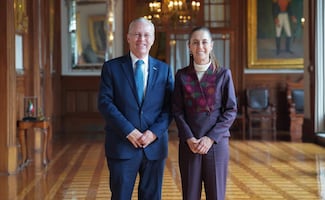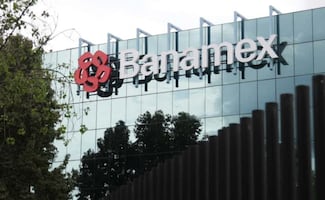Más Información

Sheinbaum se reúne con José Medina Mora en Palacio Nacional; asumirá la presidencia del CCE el 10 de diciembre, detalla

EU entregó a México lista con nombres de espías rusos, reporta el NYT; el gobierno mexicano los dejó quedarse, dice

Embajada de EU pide información sobre paradero de Ryan Wedding, exatleta ligado al Cártel de Sinaloa; recompensa es de 15 mdd

Sheinbaum entra a la lista de las 67 personas más elegantes de 2025; The New York Times destaca los bordados mexicanos en su indumentaria

“Es un camino largo, pero con amor lo hace uno”; peregrinos de diversos estados comienzan a llegar a la Basílica de Guadalupe
The 2017 earthquakes uncovered Loma Tendoma’s Tomb 1, which is located in Santiago Tillo in Nochixtlán, Oaxaca ; nevertheless, due to conservation matters, it will be buried once again, although the mortuary chamber will be available through a reproduction.
Between May 2019 and March 2020, the tomb was the site of consolidation and preservation works that were financed by Switzerland.
The detailed registry that was made in the tomb will allow making a replica that will be displayed in an exhibition space within the community’s cultural center.
“The tomb’s replica , a kind of diorama, is the technical and museographical solution that was performed and that will allow those who visit Santiago Tilla, northeast of the citiy of Oaxaca , to know the spatial and ornamental characteristics of the ancient funeral place,” said restaurateur María Cristina Ruiz Martín.
Recommended:
Inside the tomb, experts registered and recovered the bone remains of three children and four adults, that belonged to high-hierarchy individuals that were buried there from 300 to 900 A.C.; some of them had previous stones dental inlays
At the site, they also found 45 daily-use objects of which 25 are ceramic pieces including 12 pots with the pigments that were used to decorate the space and two alabaster cups.
María del Carmen Castro, head of the National Coordination for the Conservation of Cultural Heritage (CNPC), explained that the inhabitants of that communities informed personed from INAH’s Center in Oaxaca , which led to the archeological rescue works led by doctor Marcus Winter.
Eric Mayoraz, Switzerland's ambassador in Mexico, informed that every year, Switzerland’s Culture Ministry selects and finances initiatives of this kind throughout the world since the agreement between both governments regarding the importation, recovery, and protection of cultural heritage in 2018 entered into force, Mexico has a priority in the fund; another project that has received the benefits is that of the Great Mayan Aquifer.
Once the resources were approved, Loma Tendoma’s Tomb 1 was visited by a team of CNPC professionals comprised of restaurateurs Mónica Vargas Ramos, María Cristina Ruiz Martín, Teresita López Ortega, and Dulce María Grimaldi, as well as ethnologist Franco Mendoza, who designed several activities for the Santiago Tillo community to recover its past.
Grimaldi explained that the mortuary space – which is 2 meters long and 2 meters wide – is comprised of two rectangular chambers linked by a central hallway. The access to the main room has a stone lintel with eight magnificent glyphs, “engraved in a Zapotec style,” covered by red pigment.
The figures in the walls, she added, are also glyphs from the ritual calendar and represent the names of people, possibly, from different lineages. The names are comprised of a symbol: “rabbit,” deer,” “lizard,” or “house,” plus a number.
At the tomb , experts identified a total of 28 glyphs that correspond to the nuiñe writing style of the Low Mixtec, which makes reference to the calendar names of 12 couples and four individual characters.
Recommended:
“The tomb was built by digging the space in the soil, as a kind of hole. Then, they covered the walls with blocks of different kinds of stones: limestone, sandstone, and basalt, which are found in this region of the High Mixtec, and that were glued with red soil.”
For the conservation of the space, the stones were flattened to level the surface and receive the color of the natural pigments: “we have two shades of yellow, one green, two reds, pink, black, and white. The Loma Tendoma’s Tomb reflects delicacy and mastery in its making, in addition to having a warm but solemn interior atmosphere,” said Grimaldi.
The expert, who has been part of international projects such as the restoration of the Tebana Tomb 39 IN Luxor, Egypt, said that the Mixtec grave was found in a good state of conservation, except for roots growth, the fall and loss of some of the leveling, the disintegration and fragmentation of stone supports, and the dustability of pigments.
Dulce María Grimaldi asserted that leaving the Loma Tendoma Tomb uncovered was to condemn it to destruction for it needs stable conditions of temperature and humidity since abrupt environmental changes can irreversibly affect the preservation of each of its elements.
“The decisión of re-burying it – through a reversible system of layers that isolates the site from its surroundings and prevents the proliferation of salts, fungus, and other agents – was taken along with the Santiago Tillo inhabitants, with the municipal president Ángel Serafín Santiago, and with Antonio Cerna, president of the Committee of Communal Property. Each inhabitant had the opportunity to visit it.”
mp
Noticias según tus intereses
[Publicidad]
[Publicidad]









